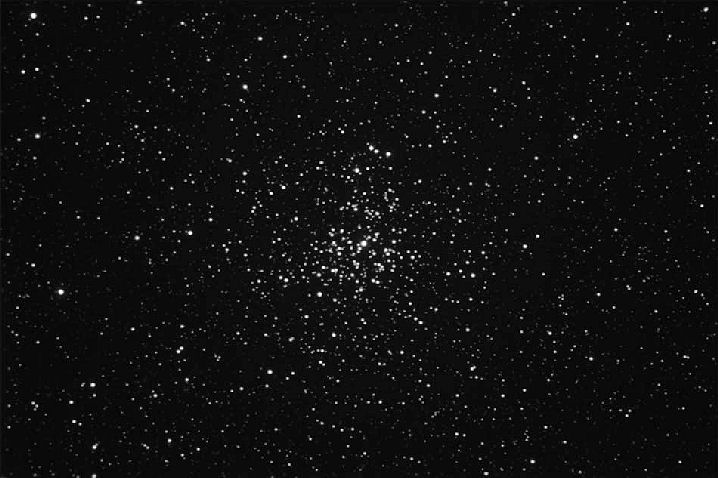Featured Site of the Month:
Home Observatories and Astrophotography — Page TwoNebulae
The Dumbbell Nebula Nebula
Located in the constellation Vulpecula, at a distance of approximately 1,360 light years, is the planetary nebula M27, also known by its given name, the Dumbbell Nebula and its New General Catalog number, NGC 6853; it was also the first planetary nebula discovered by Charles Messier in 1764. At the center of this historic nebula is a white dwarf star, one who's size is estimated to be the largest such type so far discovered. One of the nicer aspects of M27 is that in comparison to other nebulae, it is relatively luminous, with a visual magnitude of 7.4 and easily seen through a pair of binoculars. Below: "M-27 taken from Ft. Davis on 7-16-09. Exposure was RGB = 30 min. each. Processed in MaxIm and Photoshop." — Loyd Overcash.
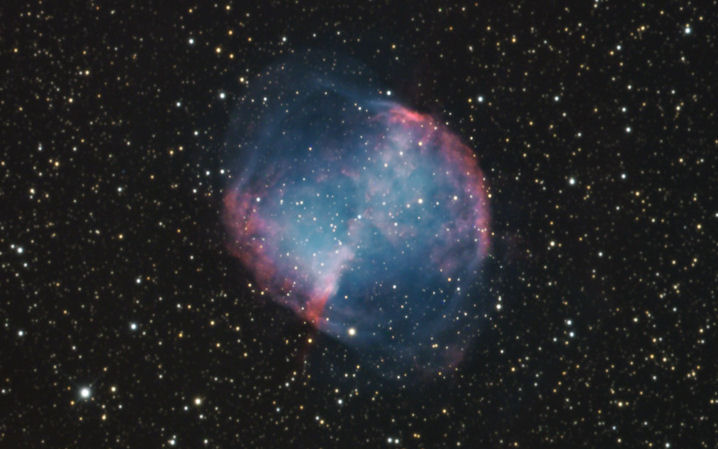
A planetary nebula is an emission nebula consisting of an expanding glowing shell of ionized gas and plasma ejected during the asymptotic giant branch (AGB) phase of certain types of stars late in their life. The name originated in the 18th century because of their similarity in appearance to giant planets when viewed through small optical telescopes, and is unrelated to the planets of the solar system. They are a relatively short-lived phenomenon, lasting a few tens of thousands of years, compared to a typical stellar lifetime of several billion years. — Planetary nebula at Wikipedia. In addition to being the second largest discovered (second in size only to NGC 7293, the Helix) nebulae like M27 are also referred to as bipolar, meaning that they are symmetric with respect to one axis which is thought to be the rotation axis of the original star. [5]
The Owl Nebula
Located within the well-known and historically rich constellation Ursa Major or "Great Bear" is the large Owl planetary nebula, also know as M97 or NGC 3587. At a little over 3' in diameter, the nebula generally appears in small telescopes as a grayish patch of light with a slightly brighter center; its form and namesake can easily be recognized by unfocusing or averting one's view slightly, bringing the "eyes" of the owl into focus which are the result of two slightly darker spots within the nebula. In addition to being host to one of the most recognizable patterns in our northern sky, the Big Dipper, Ursa Major is also the location of numerous other stellar objects that include 42 double stars, 11 galaxies and 41 variable stars. Throughout history, the constellation's Big Dipper has also been known under a variety of names such as Arktos by the Greeks, The Cart by the Bulgarians, King Arthur's chariot by the Welsh, Thor's chariot by the Germanic tribes and The Plough in English tradition. Says Loyd of his image below: "M-97, the Owl Nebula, is a Planetary Nebula located in Ursa Major. It lies about 1500 light years away. This image was taken on 1-30-06 from Ft. Davis, Tx. Exposure was L=60 min. and RGB=20 min.each." [6]
M97, the Owl Nebula in Ursa Major, is an interesting object for backyard viewing. It lies relatively nearby at 2,300 light-years from our Sun, so it appears 3.2 arcminutes in diameter - only ten times smaller than the Full Moon. The nebula's unusual name goes back to Lord Rosse, who found in 1848 a striking resemblance to the face of an owl, with two dark circular perforations and "a star in each cavity" giving the impression of two gleaming eyes. This description may sound a little over- imaginative, but if you take a look at his drawing you will see that it's accurate. — M97 - Planetary Nebula in Ursa Major courtesy the Night Sky Info website.
Located in the constellation Vulpecula, at a distance of approximately 1,360 light years, is the planetary nebula M27, also known by its given name, the Dumbbell Nebula and its New General Catalog number, NGC 6853; it was also the first planetary nebula discovered by Charles Messier in 1764. At the center of this historic nebula is a white dwarf star, one who's size is estimated to be the largest such type so far discovered. One of the nicer aspects of M27 is that in comparison to other nebulae, it is relatively luminous, with a visual magnitude of 7.4 and easily seen through a pair of binoculars. Below: "M-27 taken from Ft. Davis on 7-16-09. Exposure was RGB = 30 min. each. Processed in MaxIm and Photoshop." — Loyd Overcash.

A planetary nebula is an emission nebula consisting of an expanding glowing shell of ionized gas and plasma ejected during the asymptotic giant branch (AGB) phase of certain types of stars late in their life. The name originated in the 18th century because of their similarity in appearance to giant planets when viewed through small optical telescopes, and is unrelated to the planets of the solar system. They are a relatively short-lived phenomenon, lasting a few tens of thousands of years, compared to a typical stellar lifetime of several billion years. — Planetary nebula at Wikipedia. In addition to being the second largest discovered (second in size only to NGC 7293, the Helix) nebulae like M27 are also referred to as bipolar, meaning that they are symmetric with respect to one axis which is thought to be the rotation axis of the original star. [5]
The Owl Nebula
Located within the well-known and historically rich constellation Ursa Major or "Great Bear" is the large Owl planetary nebula, also know as M97 or NGC 3587. At a little over 3' in diameter, the nebula generally appears in small telescopes as a grayish patch of light with a slightly brighter center; its form and namesake can easily be recognized by unfocusing or averting one's view slightly, bringing the "eyes" of the owl into focus which are the result of two slightly darker spots within the nebula. In addition to being host to one of the most recognizable patterns in our northern sky, the Big Dipper, Ursa Major is also the location of numerous other stellar objects that include 42 double stars, 11 galaxies and 41 variable stars. Throughout history, the constellation's Big Dipper has also been known under a variety of names such as Arktos by the Greeks, The Cart by the Bulgarians, King Arthur's chariot by the Welsh, Thor's chariot by the Germanic tribes and The Plough in English tradition. Says Loyd of his image below: "M-97, the Owl Nebula, is a Planetary Nebula located in Ursa Major. It lies about 1500 light years away. This image was taken on 1-30-06 from Ft. Davis, Tx. Exposure was L=60 min. and RGB=20 min.each." [6]

M97, the Owl Nebula in Ursa Major, is an interesting object for backyard viewing. It lies relatively nearby at 2,300 light-years from our Sun, so it appears 3.2 arcminutes in diameter - only ten times smaller than the Full Moon. The nebula's unusual name goes back to Lord Rosse, who found in 1848 a striking resemblance to the face of an owl, with two dark circular perforations and "a star in each cavity" giving the impression of two gleaming eyes. This description may sound a little over- imaginative, but if you take a look at his drawing you will see that it's accurate. — M97 - Planetary Nebula in Ursa Major courtesy the Night Sky Info website.
Clusters
Comets
(n.) A celestial body, observed only in that part of its orbit that is relatively close to the sun, having a head consisting of a solid nucleus surrounded by a nebulous coma up to 2.4 million kilometers (1.5 million miles) in diameter and an elongated curved vapor tail arising from the coma when sufficiently close to the sun. Comets are thought to consist chiefly of ammonia, methane, carbon dioxide, and water. — Definitions of 'Comet' from The American Heritage® Dictionary
Two Tailed Comet Lulin Since Halley's comet isn't due in the night sky until the year 2062, there's no need to rush out and set up just yet. For myself, while I've had a small amount of educational experience with these vistors to our solar system, I have to admit that until recently, comets did not rank high on my objects to view list; my favorites have always been nebulae and Herbig-Haro objects. That was, until the comet Lulin (C/2007 N3, its official desigination) happend to come streaking by earlier this year; after all, who could pass up the opportunity of viewing a green comet? Certainly not I, and as for its green coloration, NASA explains: Lulin's green color comes from the gases that make up its Jupiter-sized atmosphere. Jets spewing from the comet's nucleus contain cyanogen (CN: a poisonous gas found in many comets) and diatomic carbon (C2). Both substances glow green when illuminated by sunlight in the near-vacuum of space. In addition to Lulin's green glow, a research team of Italian astronomers, led by Ernesto Guido, watched as the comet's tail suddenly separated in what is known as a disconnection event. Observing the comet, team leader Guido wrote, While we were looking, part of the comet's plasma tail was torn away. Another interesting component of Lulin's physical journey was captured in other images; this comet has not one but two tails, what is known as an "antitail", caused by sunlight illuminating dust particles strung out along the comet's orbit. Image above left showing the tail of Comet Lulin. © 2009 K. Pinkela [8]
Since Halley's comet isn't due in the night sky until the year 2062, there's no need to rush out and set up just yet. For myself, while I've had a small amount of educational experience with these vistors to our solar system, I have to admit that until recently, comets did not rank high on my objects to view list; my favorites have always been nebulae and Herbig-Haro objects. That was, until the comet Lulin (C/2007 N3, its official desigination) happend to come streaking by earlier this year; after all, who could pass up the opportunity of viewing a green comet? Certainly not I, and as for its green coloration, NASA explains: Lulin's green color comes from the gases that make up its Jupiter-sized atmosphere. Jets spewing from the comet's nucleus contain cyanogen (CN: a poisonous gas found in many comets) and diatomic carbon (C2). Both substances glow green when illuminated by sunlight in the near-vacuum of space. In addition to Lulin's green glow, a research team of Italian astronomers, led by Ernesto Guido, watched as the comet's tail suddenly separated in what is known as a disconnection event. Observing the comet, team leader Guido wrote, While we were looking, part of the comet's plasma tail was torn away. Another interesting component of Lulin's physical journey was captured in other images; this comet has not one but two tails, what is known as an "antitail", caused by sunlight illuminating dust particles strung out along the comet's orbit. Image above left showing the tail of Comet Lulin. © 2009 K. Pinkela [8]Exploding Comet
In late October of 2007, Comet 17P/Holmes made its usual journey through our solar system, its orbit around the Sun spanning a period of 6.9 years but with a magnitude of about 15 the comet was an impossible find without the aid of a telescope. However, over the span of just twenty-four hours that all changed as the comet gradually brightenend to become a million times more luminous and hence, visible to the naked eye. Noted Gill Ormrod of the UK's Science and Technology Facilities Council, It is not clear what caused this explosive event. One possibility is that it was hit by a meteoroid. More probably there has been a build-up of gas under part of the surface that catastrophically ruptured the surface last week. The comet, observed in 1899 and 1906, was thereafter lost for almost 60 years until seen once again in 1964 after which, it travelled along its path like any other normal comet until it brightened in 2007. Shown below is Loyd's 2007 image of Comet 17P/Holmes.
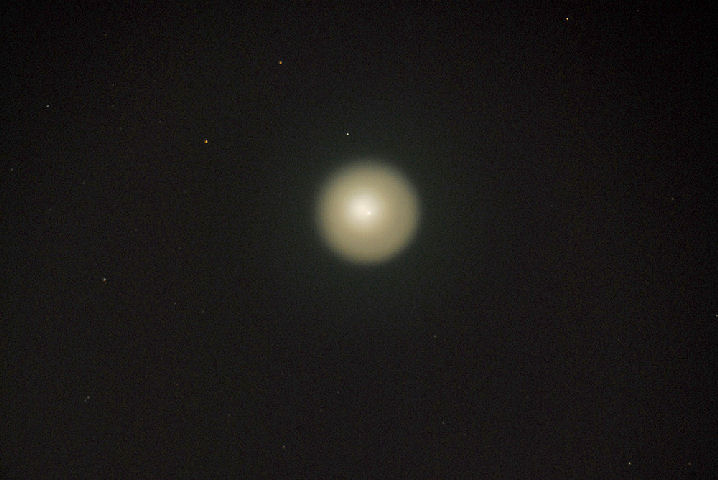
On the evening of Nov. 6, 1892, amateur astronomer Edwin Holmes was scanning the night sky above his backyard in England when he spotted something no one had ever seen before: an exploding comet. One hundred and fifteen years later, Comet 17P/Holmes is exploding again. — Loyd Overcash
Loyd's Comets — Iconic Images
When we think of a comet or picture one in our mind's eye, we often see that iconic image of a bright ball wrapped in a dusty cloud, streaking through the vacum of space, a long glowing tail streaming out behind it. Indeed, these are the components that make up a comet, called the nucleus, coma, and tail. At its heart is a solid mass or core called the nucleus around which forms a fuzzy cloud called the coma and the tail, which extends away from the comet and is, like the coma, a transient feature that is present only when the comet is near the Sun. Of a comet's tail there are two types: dust and gas ion. A dust tail, which is usually yellow, contains small, solid particles that are about the same size as those found in cigarette smoke. This tail forms because sunlight acts on these small particles, gently pushing them away from the comet's nucleus. Because the pressure from sunlight is relatively weak, the dust particles end up forming a diffuse, curved tail. A gas ion tail, which is usually blue, forms when ultraviolet sunlight rips one or more electrons from gas atoms in the coma making them into ions (a process called ionization). Below are four excellent images from Loyd's skyshooter website, each one beautifully illustrating the various components that make up a comet. To enlarge an image simply hover your mouse's cursor over the picture. Clicking on an image will open it in a new window and at a slightly higher resolution. [9]
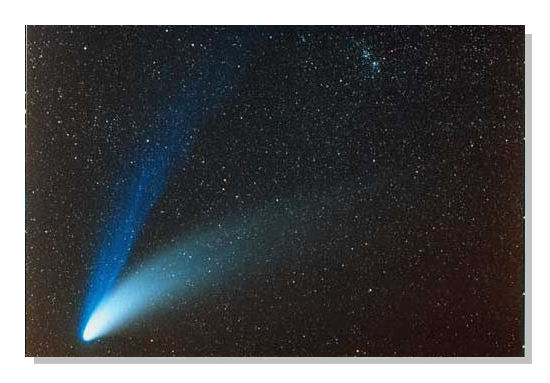
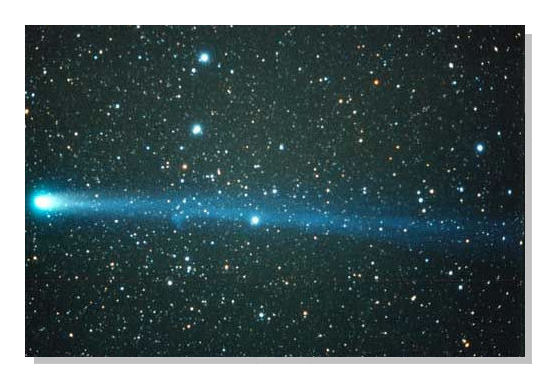


Loyd's description of his above images:
(1) Comet Hale-Bopp passing in front of the Double Cluster in Perseus. (2) Comet-Hyakutake passing in front of the handle stars of the big dipper. Taken on March 25,1996 on closest approach, only 0.1 AU or about 15 million km away. What a sight, the pale blue tail stretched over 60 deg. across the sky. (3) This shot of Comet Linear (C/2002 T7) was taken from Ft. Davis on 1-21-04. Image was taken with a Takahashi FSQ and the SBIG ST-8E. This is a 5 minute exposure. Don Pierce quotes "Those delicate streamers are tail rays, thin bundles of ionized particles and part of the ion or gas tail. This is the best image I have seen so far." (4) Comet Bradfield For those wishing to learn what comets are observable throughout the year in the northern hemisphere, check out Yoshida Seiichi`s web page COMETS FOR VIEWING in the Northern Hemisphere- a 2009 monthly calendar.
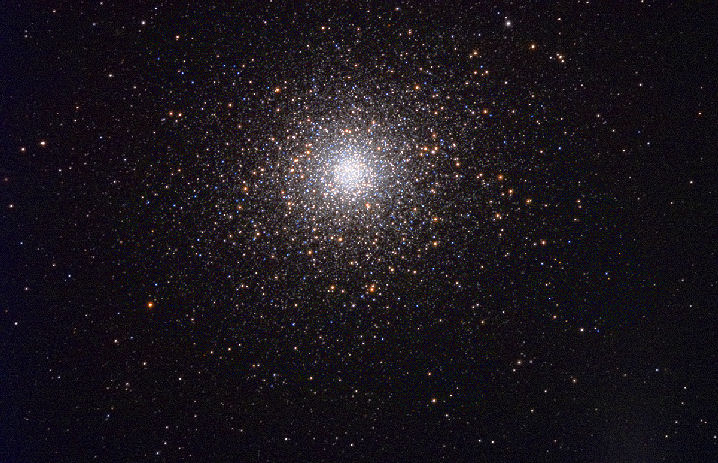
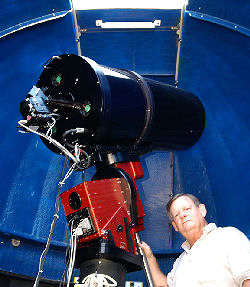
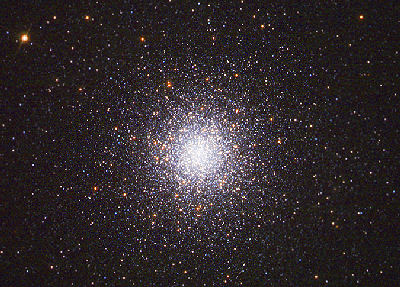 Seen at far left is an image of Loyd and his telescope, a 16-inch RCOS (RC Optical Systems) Ritchey-Chretien with Ion Milled optics. At near left, "M-3 was also taken on 6-26-09. Same as above". M3, also known as NGC 5272, is a tad brighter than M5 above, with an apparent magnitude of 6.2 (M5's apparent magnitude is 6.65) and is located 33,900 light years from Earth, in the constellation
Seen at far left is an image of Loyd and his telescope, a 16-inch RCOS (RC Optical Systems) Ritchey-Chretien with Ion Milled optics. At near left, "M-3 was also taken on 6-26-09. Same as above". M3, also known as NGC 5272, is a tad brighter than M5 above, with an apparent magnitude of 6.2 (M5's apparent magnitude is 6.65) and is located 33,900 light years from Earth, in the constellation 